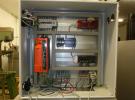Hi,
Is a resistor absolutely necessary to connect between the negative and gnd for my k type thermocouple or can i connect the negative to ground with a simple jumper? I seem to have seen both somewhere. I have other sensors installed in other ports..
Thanks.



.png%3Fitok=PHGBxf6M)


.jpg%3Fitok=B1YcuDFK)
.png%3Fitok=Ybt-OlgU)
If you connect the negative (odd) AIN channel to GND, you are now effectively doing a single-ended reading, so might as well just do a single-ended reading and not waste the odd AIN. Single-ended reading works fine with thermcouples as long as you avoid complication #5 from here:
http://labjack.com/support/app-notes/thermocouples#Complications
The U6 thermocouple tutorial uses single-ended:
https://labjack.com/support/app-notes/thermocouples/u6
that makes sense! thank you! how do we choose a resistor value. for k-type. thanks again
So if you do want to do a differential reading, you need some sort of resistor from the negative to GND so both analog inputs are not totally floating:
http://labjack.com/support/app-notes/differential-analog-inputs#differen...
The bigger the resistor, the more it acts like the thermocouple and analog inputs are isolated from GND. Better avoidance of ground loop effects and other common ground related problems.
The bigger the resistor the more Johnson noise you get. Not sure what size resistor, if any, would start to cause noticeable Johnson noise. You would have to test with your setup.
The bigger the resistor the more common-mode voltage you have. The typical bias current of the U6 analog inputs is 20 nA, so if you use a 100k resistor that means the negative channel will be sitting at roughly 0.002 volts. Allowable common mode is roughly 10 volts, so there is no practical resistor that will cause a problem here.
100k is a typical value we recommend.